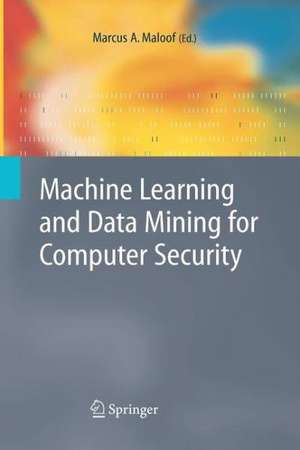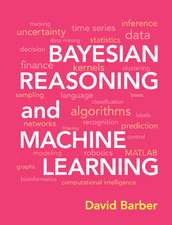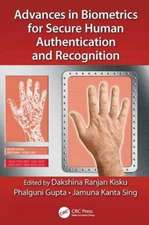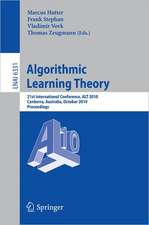Machine Learning and Data Mining for Computer Security: Methods and Applications: Advanced Information and Knowledge Processing
Editat de Marcus A. Maloofen Limba Engleză Paperback – 14 mar 2012
The first part of the book surveys the data sources, the learning and mining methods, evaluation methodologies, and past work relevant for computer security. The second part of the book consists of articles written by the top researchers working in this area. These articles deals with topics of host-based intrusion detection through the analysis of audit trails, of command sequences and of system calls as well as network intrusion detection through the analysis of TCP packets and the detection of malicious executables.
This book fills the great need for a book that collects and frames work on developing and applying methods from machine learning and data mining to problems in computer security.
| Toate formatele și edițiile | Preț | Express |
|---|---|---|
| Paperback (1) | 921.17 lei 43-57 zile | |
| SPRINGER LONDON – 14 mar 2012 | 921.17 lei 43-57 zile | |
| Hardback (1) | 931.56 lei 43-57 zile | |
| SPRINGER LONDON – 10 oct 2005 | 931.56 lei 43-57 zile |
Din seria Advanced Information and Knowledge Processing
- 20%
 Preț: 330.42 lei
Preț: 330.42 lei - 20%
 Preț: 53.43 lei
Preț: 53.43 lei - 20%
 Preț: 1042.28 lei
Preț: 1042.28 lei - 18%
 Preț: 726.85 lei
Preț: 726.85 lei - 20%
 Preț: 646.30 lei
Preț: 646.30 lei - 20%
 Preț: 990.80 lei
Preț: 990.80 lei - 20%
 Preț: 647.61 lei
Preț: 647.61 lei - 20%
 Preț: 996.56 lei
Preț: 996.56 lei - 20%
 Preț: 994.40 lei
Preț: 994.40 lei - 20%
 Preț: 985.03 lei
Preț: 985.03 lei - 20%
 Preț: 654.37 lei
Preț: 654.37 lei - 20%
 Preț: 989.79 lei
Preț: 989.79 lei - 20%
 Preț: 991.27 lei
Preț: 991.27 lei - 15%
 Preț: 645.79 lei
Preț: 645.79 lei - 20%
 Preț: 817.55 lei
Preț: 817.55 lei - 20%
 Preț: 991.46 lei
Preț: 991.46 lei - 18%
 Preț: 1114.83 lei
Preț: 1114.83 lei - 20%
 Preț: 589.92 lei
Preț: 589.92 lei - 20%
 Preț: 995.75 lei
Preț: 995.75 lei -
 Preț: 454.92 lei
Preț: 454.92 lei - 20%
 Preț: 992.62 lei
Preț: 992.62 lei - 20%
 Preț: 645.14 lei
Preț: 645.14 lei - 20%
 Preț: 647.61 lei
Preț: 647.61 lei - 20%
 Preț: 638.69 lei
Preț: 638.69 lei - 18%
 Preț: 955.08 lei
Preț: 955.08 lei - 20%
 Preț: 643.97 lei
Preț: 643.97 lei - 20%
 Preț: 983.02 lei
Preț: 983.02 lei - 20%
 Preț: 645.31 lei
Preț: 645.31 lei - 18%
 Preț: 950.96 lei
Preț: 950.96 lei - 20%
 Preț: 653.71 lei
Preț: 653.71 lei - 20%
 Preț: 988.00 lei
Preț: 988.00 lei - 18%
 Preț: 947.67 lei
Preț: 947.67 lei - 20%
 Preț: 1004.99 lei
Preț: 1004.99 lei - 20%
 Preț: 650.92 lei
Preț: 650.92 lei - 20%
 Preț: 998.21 lei
Preț: 998.21 lei - 20%
 Preț: 642.65 lei
Preț: 642.65 lei - 20%
 Preț: 988.00 lei
Preț: 988.00 lei - 20%
 Preț: 997.38 lei
Preț: 997.38 lei - 20%
 Preț: 650.59 lei
Preț: 650.59 lei - 20%
 Preț: 647.61 lei
Preț: 647.61 lei
Preț: 921.17 lei
Preț vechi: 1151.45 lei
-20% Nou
Puncte Express: 1382
Preț estimativ în valută:
176.26€ • 184.53$ • 145.85£
176.26€ • 184.53$ • 145.85£
Carte tipărită la comandă
Livrare economică 07-21 aprilie
Preluare comenzi: 021 569.72.76
Specificații
ISBN-13: 9781849965446
ISBN-10: 1849965447
Pagini: 228
Ilustrații: XVI, 210 p.
Dimensiuni: 155 x 235 x 12 mm
Greutate: 0.33 kg
Ediția:2006
Editura: SPRINGER LONDON
Colecția Springer
Seria Advanced Information and Knowledge Processing
Locul publicării:London, United Kingdom
ISBN-10: 1849965447
Pagini: 228
Ilustrații: XVI, 210 p.
Dimensiuni: 155 x 235 x 12 mm
Greutate: 0.33 kg
Ediția:2006
Editura: SPRINGER LONDON
Colecția Springer
Seria Advanced Information and Knowledge Processing
Locul publicării:London, United Kingdom
Public țintă
ResearchCuprins
Survey Contributions.- An Introduction to Information Assurance.- Some Basic Concept of Machine Learning and Data Mining.- Research Contributions.- Learning to Detect Malicious Executables.- Data Mining Applied to Intrusion Detection: MITRE Experiences.- Intrusion Detection Alarm Clustering.- Behavioral Features for Network Anomaly Detection.- Cost-Sensitive Modeling for Intrusion Detection.- Data Cleaning and Enriched Representations for Anomaly Detection in System Calls.- A Decision-Theoritic, Semi-Supervised Model for Intrusion Detection.
Recenzii
Intrusion detection and analysis has received a lot of criticism and publicity over the last several years. The Gartner report took a shot saying Intrusion Detection Systems are dead, while others believe Intrusion Detection is just reaching its maturity. The problem that few want to admit is that the current public methods of intrusion detection, while they might be mature, based solely on the fact they have been around for a while, are not extremely sophisticated and do not work very well. While there is no such thing as 100% security, people always expect a technology to accomplish more than it currently does, and this is clearly the case with intrusion detection. It needs to be taken to the next level with more advanced analysis being done by the computer and less by the human.
The current area of Intrusion Detection is begging for Machine Learning to be applied to it. Convergence of these two key areas is critical for it to be taken to the next level. The problem is that I have seen little research focusing on this, until now.
After reading Machine Learning and Data Mining for Computer Security, I feel Dr Maloof has hit the target dead centre. While much research has been done across Computer Security independently and Machine Learning independently, for some reason no one wanted to cross-breed the two topics.
Dr Maloof not only did a masterful job of focusing the book on a critical area that was in dire need of research, but he also strategically picked papers that complemented each other in a productive manner. Usually reading an edited volume like this, the chapters are very disjointed with no connection between them. While these chapters cover different areas of research, there is a hidden flow that complements the previous chapter with the next.
While Dr Maloof points out in his Preface the intended audience, I feel that there are two additional critical groups. Firstly, I feel that anyvendor or solution provider that is looking to provide a competitive advantage for their product should read this book and see exactly what the potential of next generation intrusion detection can provide. Secondly, I feel that any Computer Science student should read this book to understand the power of convergence across technologies. Everyone is searching for new solutions to intrusion detection within Computer Science and more specifically within Computer Security. But until they are willing to take a step back and provide insight and knowledge from another domain, like Dr Maloof has done, they will not find suitable answers.
This book is a must read for anyone interested in how research can improve computer security It also provides insight into additional areas of research that can be pursued. The criteria to measure a book like this is: ‘Does it get you thinking and does it nurture the creative juices from within?’ The short answer is absolutely. After reading this book, I was writing down several additional areas that I wanted to research and pursue as follow-on to reading this book. That is a key mark of a valuable book!
Dr Eric Cole, Computer Security Expert
The current area of Intrusion Detection is begging for Machine Learning to be applied to it. Convergence of these two key areas is critical for it to be taken to the next level. The problem is that I have seen little research focusing on this, until now.
After reading Machine Learning and Data Mining for Computer Security, I feel Dr Maloof has hit the target dead centre. While much research has been done across Computer Security independently and Machine Learning independently, for some reason no one wanted to cross-breed the two topics.
Dr Maloof not only did a masterful job of focusing the book on a critical area that was in dire need of research, but he also strategically picked papers that complemented each other in a productive manner. Usually reading an edited volume like this, the chapters are very disjointed with no connection between them. While these chapters cover different areas of research, there is a hidden flow that complements the previous chapter with the next.
While Dr Maloof points out in his Preface the intended audience, I feel that there are two additional critical groups. Firstly, I feel that anyvendor or solution provider that is looking to provide a competitive advantage for their product should read this book and see exactly what the potential of next generation intrusion detection can provide. Secondly, I feel that any Computer Science student should read this book to understand the power of convergence across technologies. Everyone is searching for new solutions to intrusion detection within Computer Science and more specifically within Computer Security. But until they are willing to take a step back and provide insight and knowledge from another domain, like Dr Maloof has done, they will not find suitable answers.
This book is a must read for anyone interested in how research can improve computer security It also provides insight into additional areas of research that can be pursued. The criteria to measure a book like this is: ‘Does it get you thinking and does it nurture the creative juices from within?’ The short answer is absolutely. After reading this book, I was writing down several additional areas that I wanted to research and pursue as follow-on to reading this book. That is a key mark of a valuable book!
Dr Eric Cole, Computer Security Expert
Textul de pe ultima copertă
The Internet began as a private network connecting government, military, and academic researchers. As such, there was little need for secure protocols, encrypted packets, and hardened servers. When the creation of the World Wide Web unexpectedly ushered in the age of the commercial Internet, the network's size and subsequent rapid expansion made it impossible retroactively to apply secure mechanisms. The Internet's architects never coined terms such as spam, phishing, zombies, and spyware, but they are terms and phenomena we now encounter constantly.
Programming detectors for such threats has proven difficult. Put simply, there is too much information---too many protocols, too many layers, too many applications, and too many uses of these applications---for anyone to make sufficient sense of it all. Ironically, given this wealth of information, there is also too little information about what is important for detecting attacks.
Methods of machine learning and data mining can help build better detectors from massive amounts of complex data. Such methods can also help discover the information required to build more secure systems. For some problems in computer security, one can directly apply machine learning and data mining techniques. Other problems, both current and future, require new approaches, methods, and algorithms.
This book presents research conducted in academia and industry on methods and applications of machine learning and data mining for problems in computer security and will be of interest to researchers and practitioners, as well students.
‘Dr. Maloof not only did a masterful job of focusing the book on a critical area that was in dire need of research, but he also strategically picked papers that complemented each other in a productive manner. … This book is a must read for anyone interested inhow research can improve computer security.’
Dr Eric Cole, Computer Security Expert
Programming detectors for such threats has proven difficult. Put simply, there is too much information---too many protocols, too many layers, too many applications, and too many uses of these applications---for anyone to make sufficient sense of it all. Ironically, given this wealth of information, there is also too little information about what is important for detecting attacks.
Methods of machine learning and data mining can help build better detectors from massive amounts of complex data. Such methods can also help discover the information required to build more secure systems. For some problems in computer security, one can directly apply machine learning and data mining techniques. Other problems, both current and future, require new approaches, methods, and algorithms.
This book presents research conducted in academia and industry on methods and applications of machine learning and data mining for problems in computer security and will be of interest to researchers and practitioners, as well students.
‘Dr. Maloof not only did a masterful job of focusing the book on a critical area that was in dire need of research, but he also strategically picked papers that complemented each other in a productive manner. … This book is a must read for anyone interested inhow research can improve computer security.’
Dr Eric Cole, Computer Security Expert
Caracteristici
No similar work exists Diverse and current view of area Also provides introductory background chapter for readers who are unfamiliar with inductive approaches Designed to help such readers understand the contributed chapters Includes supplementary material: sn.pub/extras
















